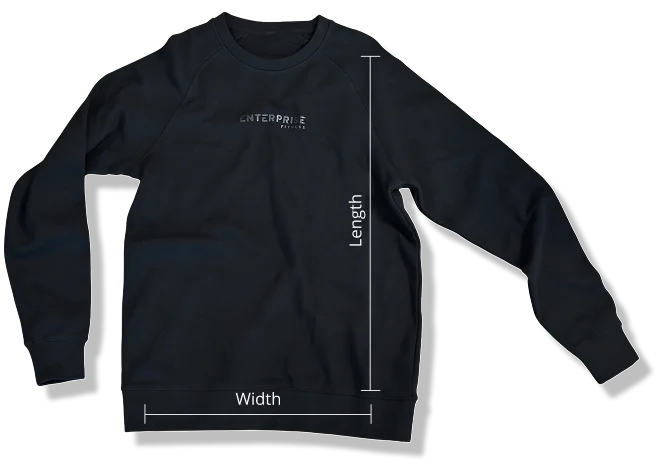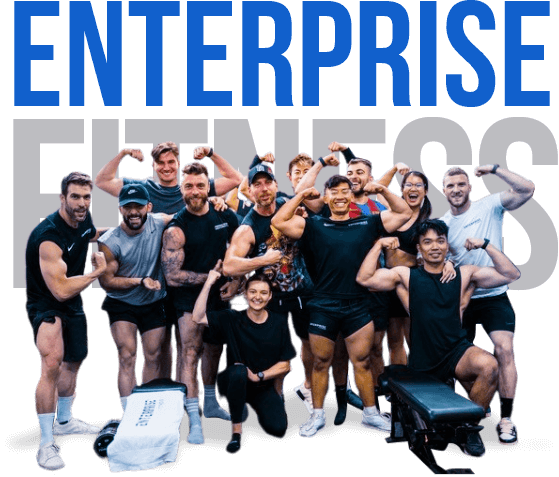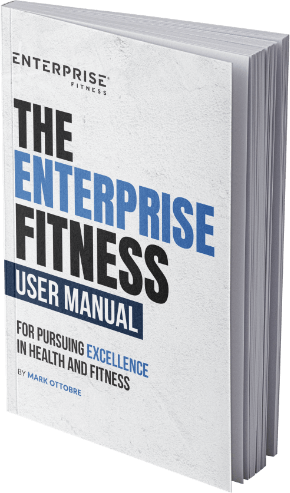We’ve put together our top 12 leg exercises for you to add into your lower body workouts.
We’ve included a variety of compound and isolated movements to hit your legs at all angles, for guaranteed leg gains.
1. Front Squat
Although this isn’t written in an officially order, Front Squat still has to be number 1. It is one of the best indicator lifts of lower body strength and performance, and in order to perform it correctly, you need to satisfy its technical strength requirement alone with good mobility.
There’s nothing comfortable about a good front squat, and that’s probably why you get so much from them.
The front bar position requires you to keep yourself up high and tall, ensuring a good thoracic extension, with the majority of the load placed on your quads.
2. Dumbbell Split Squat
The split squat is the best starting movement to fix unilateral discrepancies between legs. It will challenge both strength and mobility, hence this is often used in phase 1 of programming for clients at Enterprise Fitness.
Even for advanced clients, we include a split squat as a supplementary exercise to the main lift, in order to keep joints healthy and injuries at bay.
The split squat can be performed in a number of different ways depending on your ability. For beginners, we recommend elevating the front foot onto a step, in order to gradually introduce the range of motion.
3. High bar squat
For lower body development, you can’t go past a high bar squat. Sure, you can switch it up and use a lower bar position, but a high bar has far more carryover to overall strength rather than just squatting for numbers.
Positioning the bar at the top of your back forces you to keep yourself upright and distribute the load into your quads more so than in your posterior chain.
4. Leg Curl
Leg curl is a vital movement to making sure you have strong hamstrings. Hamstrings are predominately a fast twitch muscle group so generally speaking you will train knee flexion (leg curl) with using relative strength rep ranges.
Your foot position will determine which head of the hamstrings are being engaged. Ensure you are incorporating both plantar and dorsi flexed techniques in order to isolate and strengthen your hamstrings heads equally.
Plantar Flexed
Pointing your feet away from your body will prevent the gastrocnemius (part of your calf) being recruited in the movement. This does mean you’ll have to go lighter, but your hamstrings will be more engaged.
Dorsi Flexed
Pulling your toes towards your body will enable your hamstrings to handle more load as your gastrocnemius will be recruited to stabilise the movement as well as your hamstrings.
5. Stiff legged Deadlift
A humble hinging from the hips could be considered the mother of all movements when it comes to lower body power. Therefore, utilising a stiff legged deadlift (performed correctly) is extremely beneficial for increasing lower body power and strength.
If performed correctly, it should hit your whole posterior chain. You can alter your hand placement to a snatch grip, making the hamstrings and upper back work even harder. The key focus is to continually push your hips up and back. You should feel a pretty intense stretch in your hamstrings.
Ensure the bar is ALWAYS touching your thighs.
6. 180 hyper extension
This one can look a little intimidating, but once you’ve learnt the set up, your glutes and hammies will thank you for it!
So many people are wanting to build their glutes but neglect the 180 hyper. The 180 extension will place a lot of tension (and load) on the glutes in a fully contracted position.
Our tutorial will teach you how to get your positioning right to use your glutes and your hamstrings.
Stretch your hamstrings to the maximum!
7. Step ups
There are many ways to perform a step up; however most versions lack luster and yield very poor results.
The first point to mastering a step up is to know why you are doing it. Step ups are mainly used to strengthen the pattern of knee flexion, thus the knee should travel over the toe; in fact, the knee should initiate the movement.
Depending on your mobility and strength, the height of the step can be regressed and progressed to suit your own ability. For beginners or those with knee stability issues, start by stepping up to mid-shin level (or lower). Point the toe of the leg that isn’t working, and ‘kiss the floor’ before driving back up. This means you will have more control throughout the entire movement and knee tension can be maintained.
8. Slant board squat
One of the greatest exercises invented to blast your quads. Perform the movement with dumbbells to eliminate loading the spine.
This one is great for rehab or for those that need to build a wider base of performance.
The significant elevation of the heel means that you will be able to engage your quads a lot more than in a normal squat, it also means it will be easier to achieve full depth. As the heels are elevated it will minimise the recruitment of the glutes and hamstrings and maximise the engagement of the quads.
If you’re struggling to keep yourself upright, get someone to hold a stick in front of you, or perform this facing close to a wall. As you move through the squat, keep your body parallel to it, without falling forwards.
9. 1 1/4 Lunge
A lunge with a quarter movement at the end range will maximise the engagement of your quads. It should (if performed correctly) slow down the movement to increase time under tension, which is exactly what you want for building muscle and a great Vastus Medialis.
Adding a block to elevate the front foot enables the knees to travel more freely over the toes, and emphasise the load on the Vastus Medialis.
Add these movements into your leg sessions, just make sure to follow our tutorials to ensure you are performing the exercises with correct technique.
10. Seated calf raise
Although the majority of people perceive training calves as just an accessory for bodybuilders, calf raises are actually a great preventative for lower body injuries.
Mobilising the ankle joint will in turn help knee flexion, and allow you to squat deeper and place a greater load on your quads.
It specifically targets the soleus which is heavily involved in decelerating the knee. This is not ‘just’ for bodybuilders or people who want bigger calves, there is practically in training them.
11. 45d Hyper
This is our go-to for introducing a hip hinge to new clients or anyone unfamiliar with weight training.
Although similar technique to the 180 degree hyper; the change in angle requires more hamstring and lower back engagement and less glutes.
Although technically you will be working hamstrings, glutes and lower back in both exercises, the engagement of each is different.
As people advance, we like to load these with a bar, give small weight plates to hold in your hands or perform the superman variation.
12. Leg extension
It is often overused! This can result in tightening of the hip flexors, and in turn will lead to poor squat mechanics. With that said, for isolating the quads, it simply cannot be beat.
A lot of people are under the impression that leg extension isn’t a healthy movement for the knees. However, if you are set up correctly, and controlling the movement right, it’s perfectly safe to perform. Keep your knees straight, and don’t allow them to roll in.
If you want to build your quads, this exercise is a no brainer.
Add these movements into your leg sessions to transform your training results. Just make sure to follow our tutorials to ensure you are performing the exercises with correct technique.
Article written by Enterprise Fitness, Australia’s leading personal training studio focused on producing head-turning results and life-changing transformations.





